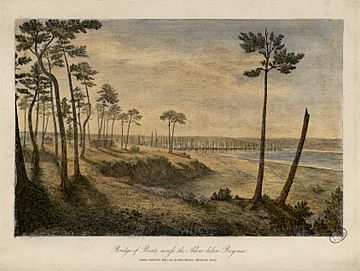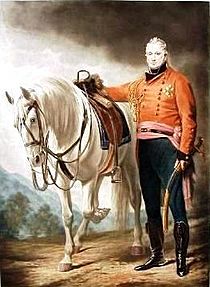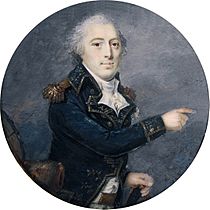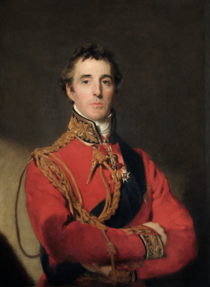Battle of Bayonne facts for kids
Quick facts for kids Battle and Siege of Bayonne |
|||||||
|---|---|---|---|---|---|---|---|
| Part of the Peninsular War | |||||||
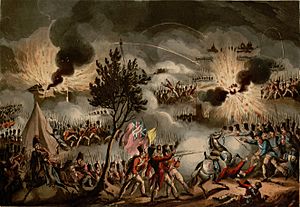 "The Sortie from Bayonne, at 3 in the Morning, on the 14th April 1814" by Thomas Sutherland |
|||||||
|
|||||||
| Belligerents | |||||||
| Commanders and leaders | |||||||
| Strength | |||||||
| 14,000 | 25,000–31,000 | ||||||
| Casualties and losses | |||||||
| Battle: 910 Siege: 2,000 |
Battle: 838 Siege: 2,000 |
||||||
The Battle of Bayonne was a fight that happened on April 14, 1814, during the Peninsular War. It involved French soldiers defending the city of Bayonne against British, Portuguese, and Spanish troops. This battle was one of the last major fights of the war.
The battle took place even though news of Napoleon giving up his power (called abdication) had already reached the armies. The French commander, Pierre Thouvenot, decided to attack the Allied forces who were surrounding Bayonne. The Allies had started a siege of Bayonne by building a special floating bridge across the Adour River. This allowed them to completely surround the city.
The fighting on April 14 was very intense, with a lot of hand-to-hand combat. Even though the French had some early success, the Allied forces pushed them back. Both sides lost many soldiers. The siege continued until April 17, when the main French army signed a peace agreement. However, Thouvenot kept fighting until he received direct orders to stop.
Contents
How the Siege of Bayonne Started
Armies Prepare for Battle
After the Battle of the Nive in December 1813, heavy rains made it hard for armies to move. The British commander, Duke of Wellington, refused to fight in the bad weather. He said it would be a "useless waste of men." The armies stayed put until mid-February 1814.
Meanwhile, French Marshal Jean-de-Dieu Soult had to send some of his troops to fight in another part of France. Soult tried to get local French people to fight against the Allied army, but it didn't work. Allied troops could move safely in the areas they controlled.
Soult thought Wellington would try to cross the Adour River east of Bayonne. So, he placed his troops to block that path. But Wellington had a different plan. He wanted to move his main army east to draw Soult away from Bayonne. This would allow John Hope's troops to surround Bayonne.
Surrounding Bayonne City
By February 14, 1814, the weather improved. Wellington's troops began moving east, forcing the French to retreat. On February 15, Wellington's army won a small battle at Garris. Wellington's army had about 42,000 foot soldiers and 3,000 cavalry. Soult's army had 32,000 foot soldiers and 3,800 cavalry after sending some troops to Bayonne.
Wellington wanted Hope's army to cross the Adour River near its mouth, west of Bayonne. This would allow them to completely surround the city. Over 50 small ships, called chasse-marées, were gathered. They were loaded with wood and ropes to build a floating bridge. A hidden battery of cannons was also set up to protect the crossing.
On February 22, the wind calmed down, and the ships sailed towards the Adour River. The next morning, British troops were ready to cross, but the ships were not there. They had been blown off course by strong winds. Hope decided to send small groups across the river in boats. By the end of the day, about 500 British soldiers were on the north bank.
The French commander, Thouvenot, had 2,700 soldiers in Bayonne's citadel. But he didn't try to stop the small British force from crossing. Instead, he sent about 700 soldiers to check things out. These French troops were hit by Congreve rockets and quickly retreated.
By dawn on February 24, more Allied soldiers had crossed the river. The ships finally arrived and entered the Adour. By noon, 3,000 men were across, and by nightfall, 8,000 troops were safely on the north bank. This made the bridgehead (the area controlled on the other side) secure.
The floating bridge was built between February 25 and 26. Twenty-six ships were anchored side-by-side across the river. They were tied together with cables. The Allied forces were then split: 15,000 men on the north bank and 16,000 on the south bank. The French remained surprisingly quiet during this time.
However, when the Allies tried to capture the Saint-Étienne suburb, there was a fierce fight. The Allies lost almost 400 soldiers. On February 27, the Allies finally captured Saint-Étienne in house-to-house fighting. The British and Portuguese had minor losses, but some German battalions lost 328 men. The French lost 55 killed and 103 wounded. On the same day, Wellington's main army defeated Soult's army at the Battle of Orthez.
After this, Thouvenot didn't bother the Allied siege lines much. Wellington wanted to use the Adour River for supplies, but large ships couldn't cross the sandbar at the river's mouth. So, supplies came from Saint-Jean-de-Luz, across the new bridge, and then around Bayonne.
The Battle of Bayonne
General Hope was in charge of the siege, but he was very slow. He thought the French would run out of food and surrender soon. But the city had enough food for many weeks. Soldiers on both sides often got along, exchanging goods and letters.
On April 10, Hope learned that Napoleon had given up his power. But he didn't tell the French commander, Thouvenot, right away. This news, however, leaked into Bayonne, and more French soldiers started leaving their posts.
On April 12, Thouvenot also heard the unofficial news about Napoleon. Even though the war was almost over, he decided to attack. He gathered 6,000 of his best soldiers. His plan was to surprise the Allies and take back the Saint-Étienne suburb. A French soldier who left his post told the Allies about the attack, but they were still surprised by how strong it was.
The attack happened at 3:00 am on April 14, a very dark night. The French attacked the Allied outposts (small groups of soldiers guarding an area) and quickly overwhelmed them. The French captured Saint-Étienne, and the British General Andrew Hay was killed defending a church.
The French also attacked other parts of the Allied lines. General Hope and some of his officers were captured. French cannons fired from the citadel, but they didn't do much damage. French engineers started to destroy the Allied defenses.
With Hope captured, other officers took charge. General Henry de Hinuber had kept his German battalions ready. He quickly gathered troops and launched a counter-attack with Portuguese soldiers. They pushed the French out and took back Saint-Étienne. Other Allied forces also counter-attacked.
The Allied counter-attack grew stronger. The French were being attacked from both sides. Thouvenot ordered his troops to retreat. The French suffered heavy losses as they tried to pull back in the dark. By 8:00 am, the Allies had taken back all the lost ground. The siege guns were not damaged. After Hope was captured, General Charles Colville took command of the Allied forces.
What Happened Next
The Allies lost 838 men in the battle. This included 150 killed, 455 wounded, and 233 captured (including General Hope). The French reported losing 905 men, with 11 officers and 100 men killed.
On April 12, two officers brought official news to Wellington that Napoleon had given up his power. This news was also taken to Marshal Soult, the main French commander. Soult didn't believe the papers at first and refused to stop fighting. But on April 17, after receiving another message, Soult finally agreed to a peace agreement with Wellington.
After the battle on April 14, General Colville sent Thouvenot some newspapers saying Napoleon was gone. But Thouvenot refused to believe it. He even congratulated his troops in Napoleon's name. He said he would only stop fighting if he got a direct order from a higher-up.
Finally, on April 27, Thouvenot received Soult's copy of the peace agreement. This forced him to hand over the fortress of Bayonne to the British. The Battle of Bayonne was one of the last fights of the Peninsular War.
|


